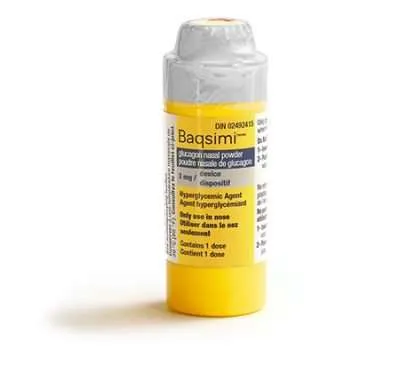Baqsimi Nasal Glucagon Spray
$237.95
Baqsimi
Glucagon
Reasons to buy

Baqsimi Nasal Glucagon Spray
Anyone who is on insulin is at risk for low blood sugar emergencies, making it important to have a product on hand to reverse the effects. Baqsimi is a great option when oral carbohydrates, sugar, or glucose tablets do not work. It is a single-dose product that is inhaled as a puff through the nose. It is indicated for the treatment of severe hypoglycemia for adults and children ages four and up.
HOW DOES BAQSIMI NASAL GLUCAGON SPRAY WORK?
Baqsimi functions by elevating the concentration of glucose in the blood. It works through activating glucagon receptors, Gs? and Gq, in the liver, initiating the breakdown of glycogen and the release of glucose by the liver. In order for glucagon to elicit anti-hypoglycemic effects, there must be glycogen stores in the liver.
HOW SUPPLIED
Baqsimi is provided as a nasal powder within a device. Each device contains 3 milligrams (mg) of glucagon in a white powder. Each device contains a single dose of glucagon.
SIDE EFFECTS
- Nausea
- Vomiting
- Headache
- Nose discomfort
- Runny or stuffy nose
- Eye redness
- Itchy nose, throat, and eyes
- Watery eyes
WARNINGS AND PRECAUTIONS
A pheochromocytoma is a tumor located the adrenal glands that secretes hormones. Baqsimi should not be used in those with pheochromocytoma. This is because glucagon can cause catecholamine release from an existing tumor. If a patient experiences a significant increase in blood pressure, one can suspect an undiagnosed pheochromocytoma. In this event, providers should administer intravenous phentolamine mesylate at a dose of 5 to 10 milligrams (mg). This treatment has been efficacious in lowering a patient’s blood pressure.
Hypoglycemia in Those with Insulinoma
Those who have insulinoma (pancreas tumors) may experience an increase in blood glucose when they receive Baqsimi. This phenomenon can trigger an extensive release of insulin from an insulinoma, resulting in hypoglycemia. Therefore, Baqsimi should not be used in patients with insulinoma. If a patient experiences hypoglycemic symptoms after receiving Baqsimi, they should be administered oral or intravenous glucose.
Hypersensitivity and Allergic Reactions
Some patients have had allergic reactions after being administered glucagon. Symptoms have included rash, anaphylactic shock, difficulties breathing, and hypotension. Patients should not use Baqsimi if they have had a prior allergic reaction to glucagon products.
Absence of Efficacy in Patients with Decreased Hepatic Glycogen
Baqsimi will only work on hypoglycemia if there is enough hepatic glycogen available. Individuals who are in states of starvation, with adrenal insufficiency, or with chronic hypoglycemia often do not have enough hepatic glycogen present. Therefore, Baqsimi may not be effective in these types of patients. Individuals with these specific conditions should instead be administered glucose.
DRUG INTERACTIONS
Beta-blockers
Individuals who are on beta-blockers may have transient elevations in pulse and blood pressure after being administered Baqsimi.
Indomethacin
In individuals who are on indomethacin, Baqsimi may not be effective. Baqsimi may not be able to increase blood glucose and may even cause hypoglycemia.
Warfarin
Baqsimi may elevate warfarin’s anticoagulant effects. Providers should take caution when dosing warfarin in patients on Baqsimi.
USE IN SPECIFIC POPULATIONS
Pregnancy
In pregnant rat models, there was no sign of increased risk of malformations or embryofetal death.
Lactation
There is no information available on how Baqsimi may affect a breastfed infant or milk production. Glucagon is a peptide that should be broken down into individual amino acids within an infant’s digestive tract. Because of this, harm to the infant is not likely if they were to be exposed.
Pediatrics
Baqsimi is known to be safe and effective in children ages 4 and above. However, there is no data on the safety and efficacy of Baqsimi in those younger than 4 years old.
| Quantity | 3mg – 1 device |
|---|
